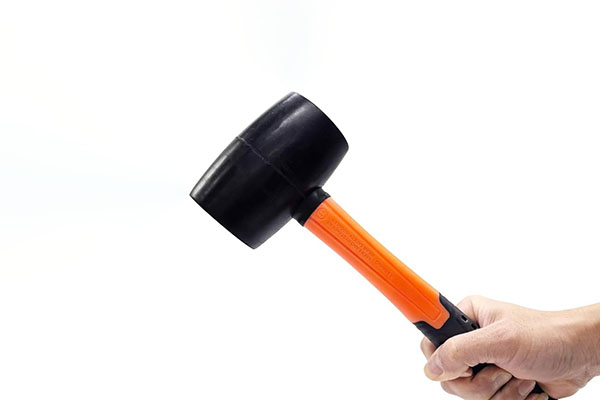A رٻڙ جي چادر ڪاٺ جي ڪم، تعمير، ڪئمپنگ، ۽ مختلف DIY منصوبن ۾ استعمال ٿيل هڪ ورڇيل اوزار آهي. روايتي اسٽيل هامر جي برعڪس، هڪ ربر مالٽ نرم ڌڪ پهچائي ٿو، سطح جي نقصان کي گھٽائي ٿو جڏهن ته اڃا تائين مواد کي گڏ ڪرڻ لاء ڪافي قوت مهيا ڪري ٿي. جيڪڏهن توهان هڪ خريد ڪرڻ تي غور ڪري رهيا آهيو، توهان حيران ٿي سگهو ٿا: هڪ ربر مالٽ ڪيترو وزن هجڻ گهرجي؟ مثالي وزن ڪم جي قسم تي منحصر آهي جيڪو توهان ڪرڻ جو ارادو ڪيو، مواد جيڪو توهان ڪم ڪري رهيا آهيو، ۽ ڪنٽرول جي سطح توهان کي گهربل آهي.

سمجھڻ ربر مالٽ وزن
ربر مالٽ مختلف سائزن ۽ وزنن ۾ اچن ٿا، عام طور تي 8 آونس کان 32 آونس. مالٽ جو وزن سڌو سنئون اثر انداز ڪري ٿو ته توهان هر هڙتال سان ڪيتري قوت لاڳو ڪري سگهو ٿا:
-
هلڪو مالٽ (8-12 اوز): نازڪ ڪم لاءِ بھترين جتي ڪنٽرول ۽ سڌائي اثر قوت کان وڌيڪ اهميت رکي ٿي.
-
وچولي وزن وارا مالٽ (16-24 اوز): ورسٽائل ۽ اڪثر عام مقصدن جي ڪمن لاءِ موزون، طاقت ۽ ڪنٽرول جي وچ ۾ سٺو توازن پيش ڪري ٿو.
-
ڳري مالٽ (28-32 اوز يا وڌيڪ): نوڪريءَ لاءِ ٺهيل آهن جن کي اهم قوت جي ضرورت آهي، جهڙوڪ ڳري ٽائلس لڳائڻ يا گندي مواد سان ڪم ڪرڻ.
صحيح وزن چونڊڻ توهان جي مخصوص ضرورتن تي منحصر آهي.
غور ڪرڻ جا عنصر جڏهن وزن چونڊيو
1. پروجيڪٽ جو قسم
جيڪڏھن توھان فرنيچر گڏ ڪري رھيا آھيو، نرم ڪاٺ سان ڪم ڪري رھيا آھيو، يا خيمه جا حصا لڳائي رھيا آھيو، هلڪو کان وچولي وزن وارو مالٽ (12-16 اوز) عام طور تي ڪافي آهي. اهي وزن نقصان جي خطري کان سواء ڪم ڪرڻ لاء ڪافي اثر مهيا ڪن ٿا.
ڳري ڊيوٽي ايپليڪيشنن لاءِ جيئن پيور لڳائڻ، سخت ڪاٺ جي فرش کي ترتيب ڏيڻ، يا گاڏين جي حصن سان ڪم ڪرڻ، a ڳري مالٽ (24-32 اوز) وڏي طاقت لاء ضروري ٿي سگهي ٿو.
2. مٿاڇري جو مواد
مختلف سطحن کي طاقت جي مختلف سطحن جي ضرورت آهي:
-
نرم مواد ڪاٺ يا پلاسٽڪ وانگر، ڏندن کي روڪڻ لاءِ هلڪي ڦوڪ جي ضرورت هوندي آهي.
-
سخت مواد جهڙوڪ پٿر يا ڌاتو کي وڌيڪ اثر جي ضرورت آهي، هڪ ڳري مالٽ کي وڌيڪ اثرائتو بنائڻ.
3. استعمال ڪندڙ جي طاقت ۽ آرام
هڪ اوزار کي پڪڙڻ ۽ جھولڻ ۾ آرام محسوس ڪرڻ گهرجي. جيڪڏهن مالٽ تمام ڳري آهي، ته توهان ڪنٽرول وڃائي سگهو ٿا يا جلدي ٽائر، جيڪو حفاظت ۽ درستگي سمجهي سگهي ٿو. برعڪس، هڪ مالٽ جيڪو تمام روشن آهي شايد گهربل اثر حاصل ڪرڻ لاء اضافي ڪوشش جي ضرورت هجي.
4. استعمال جي تعدد
جيڪڏهن توهان پروفيشنل ڪم لاءِ باقاعده هڪ ربر مالٽ استعمال ڪندا آهيو، ڪيترن ئي وزنن ۾ سيڙپڪاري فائديمند ٿي سگهي ٿي. هي توهان کي هر ڪم لاء ڀرپور اوزار چونڊڻ جي اجازت ڏئي ٿو.
عام استعمال جا ڪيس ۽ تجويز ڪيل وزن
-
فرنيچر اسيمبلي: A 12-16 اوز مالٽ جوڑوں کي آسانيءَ سان ٽيپ ڪرڻ لاءِ مثالي آهي بغير ڪنهن نقصان جي.
-
ٽائل لڳائڻ: A 16-24 اوز مالٽ ٽائلس کي دٻائڻ لاءِ چڱيءَ طرح ڪم ڪري ٿو انهن کي ٽوڙڻ کان سواءِ.
-
ڪئمپنگ ۽ خيمه جا حصا: A 16 اوز مالٽ ٿلهي وزن ۽ ٻاهرين استعمال لاء پورٽبل آهي.
-
پيور يا معمار جو ڪم: A 24-32 اوز مالٽ ڳري پٿر يا سرن جي پوزيشن لاءِ گهربل قوت مهيا ڪري ٿي.
ٻٽي سرن وارا مالٽ
ڪجهه رٻڙ مالٽ ٻه سرن سان گڏ ايندا آهن - هڪ نرم ۽ هڪ مضبوط. اهي اڪثر ڪري وزن کڻندا آهن 16-24 اوز، انهن کي ڪمن جي وسيع رينج لاءِ موزون بڻائي ٿو. اھي لچڪدار پيش ڪن ٿا جڏھن توھان کي تبديل ڪرڻ جي ضرورت آھي لائٽر ۽ بھاري ڌڪن جي وچ ۾ بغير اوزار تبديل ڪرڻ جي.
نتيجو
سو، ڪيترو وزن گهرجي a رٻڙ جي چادر هجڻ؟ ڪو به هڪ-سائيز-فٽ-سڀ جواب ناهي. لائيٽ ڊيوٽي منصوبن ۽ نازڪ سطحن لاءِ، الف 12-16 اوز مالٽ بهترين ڪم ڪري ٿو. وچولي ڊيوٽي ايپليڪيشنن لاءِ جيئن ٽائل جو ڪم يا فرش، 16-24 اوز مٺي جڳهه آهي. ڳري فرض جي ڪمن لاءِ، وڃو a سان 24-32 اوز مالٽ وڌ ۾ وڌ طاقت لاء. بالآخر، صحيح وزن توهان جي مخصوص نوڪري ۽ آرام جي سطح تي منحصر آهي.
صحيح مالٽ ۾ سيڙپڪاري توهان جي ڪم جي سطحن لاءِ بهتر ڪنٽرول، ڪارڪردگي ۽ تحفظ کي يقيني بڻائي ٿي.
پوسٽ ٽائيم: سيپٽمبر-05-2025






